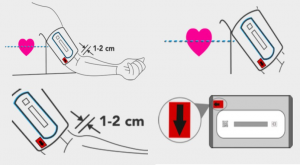When it comes to measuring your blood pressure, technique really matters. Doing it wrong can give you a reading that’s too high or too low. It’s affected by the way you wear your cuff and your measurement position, so try to be consistent in the way you take measurements. Here is a list of 10 simple tips to make your reading more consistent:
Tip #1: In the 30 minutes before testing your blood pressure, avoid caffeinated or alcoholic drinks and don’t smoke.
Tip #2: Try to take your blood pressure at the same time each day. It will vary throughout the day. Doing this in the morning as part of your daily routine is a good time, or whenever your Doctor recommends you perform a reading.
Tip #3: Sit down and relax for 2-3 minutes before each measurement. This is important to get consistent readings. It is often easier to do this at home when there is less stress.
Tip #4: Posture is important – sit in a chair, with feet flat on the floor, legs uncrossed. Rest your arm on a table located in front of you or at the side so that the Blood Pressure Monitor is level with your heart (See Figure 1).
Tip #5: Remove clothing on the upper-arm so that the cuff can be placed on bare skin. Do not attempt to use an upper-arm cuff on your wrist, as the bones and tendons interfere with an accurate blood pressure reading and it will not have been calibrated for use at the wrist.
Tip #6: The bottom of the cuff should be 1-2 cm (about 1 or 2 fingers) above the bend of your elbow.


Tip #7: Ensure your Blood Pressure Monitor cuff is secured firmly together at the Velcro patches to stop the cuff slipping up or down on the upper-arm for a more consistent reading.
Tip #8: Keep still for the duration of measurement. Moving, talking, eating, drinking or any other activity will produce errors.
Tip #9: Use the same arm each time. Ideally the left arm (if you are right-handed) or vice versa.
Tip #10: Completely deflate the cuff and wait 3-5 minutes between readings if you decide to take another measurement. Remember that the cuff applies pressure and this restricts blood flow into your lower arm.
